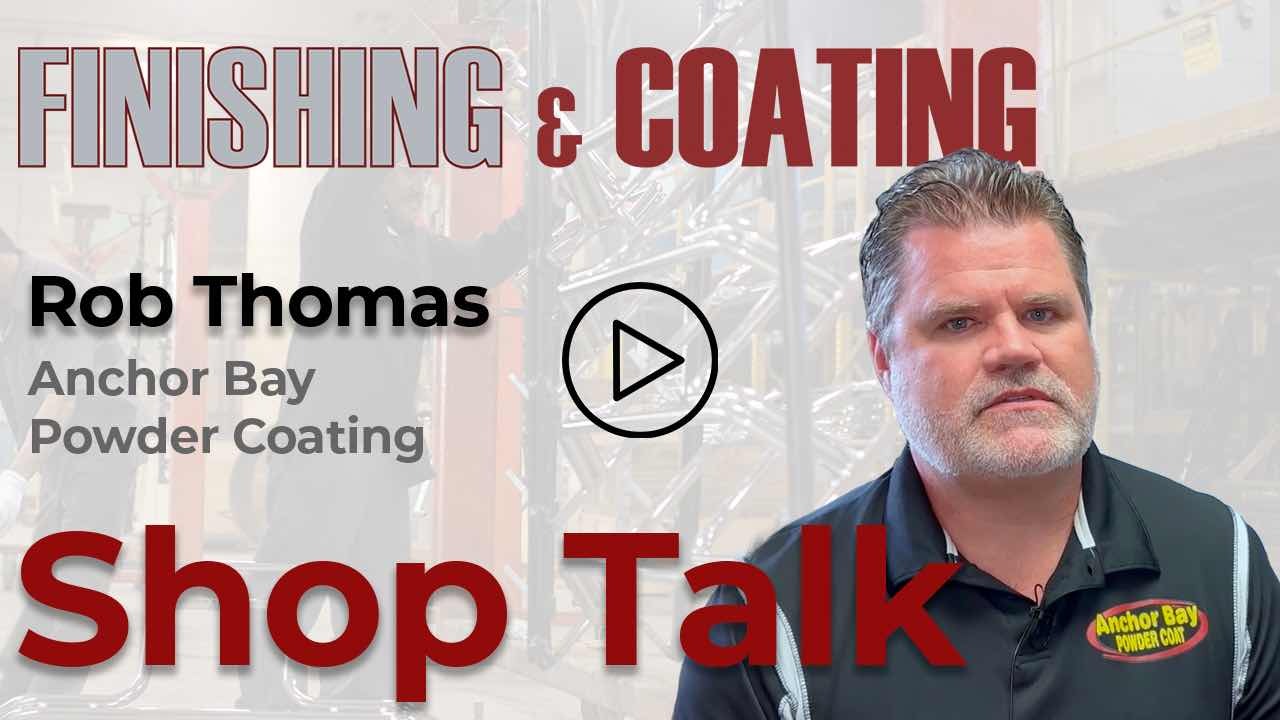When owner Rob Thomas looks at his management team at Anchor Bay Powder Coat in New Baltimore, Michigan, he sees several people who have played a big role in the success of his company.
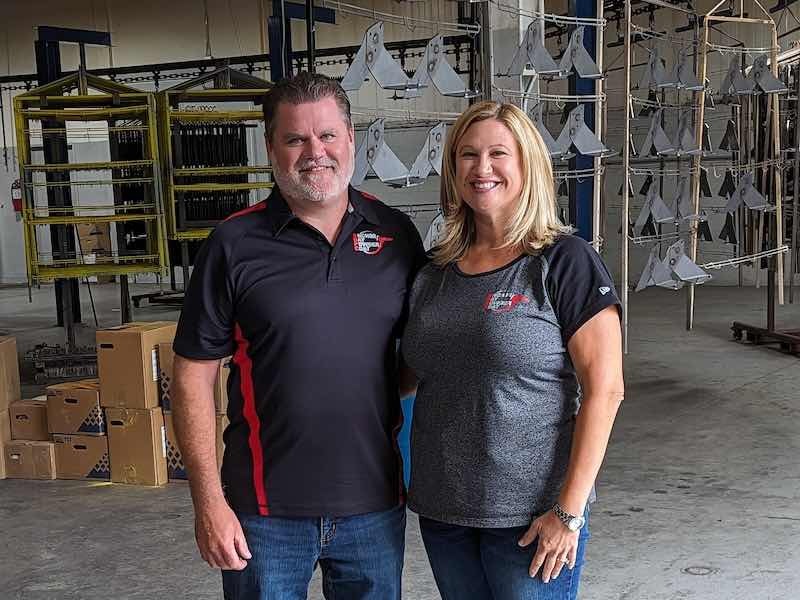 Rob and Sarah Thomas are owners of Anchor Bay Powder Coat.But when he had just 25 total employees a few years back, he often wondered if he was too top-heavy in his company’s structure.
Rob and Sarah Thomas are owners of Anchor Bay Powder Coat.But when he had just 25 total employees a few years back, he often wondered if he was too top-heavy in his company’s structure.
“I probably have too many managers,” says Thomas. “But I have people that have been with me long enough that made it to that level. And when we started picking up more work, it was those people who were able to divide and conquer and were committed to working along with me to do whatever we had to do because we were shorthanded.”
Being understaffed is not a problem any longer, as Anchor Bay’s staff is up to almost 50 employees to handle the growing work the company keeps attracting. For Thomas, he is glad he has talented managers who can handle the upswing in customers.
“Prior to that, if I didn’t have those guys in place, there just would have been no way to do it,” he says. “I couldn’t have done it by myself, and I really have those guys to thank for it. But I’ve always taken very good care of the people that work for me that are committed to what we’re doing. I take good care of them, and I think that’s what got us through.”
Origins from Autobody Finishing Operation
Anchor Bay Powder Coat is a 15-year-old shop that applies powder and liquid coating along with sandblasting and oven burn-off. Its roots go back to Thomas’ parent’s autobody finishing operation and a need to offer better coatings and improved quality to customers located about 35 miles northeast of Detroit.
The company has two locations about 1.5 miles from each other: a 20,000-square-foot location that houses the original operation and a 33,000-square-foot spot that was needed to handle the additional work that ABPC has taken in over the last few years.
In fact, Thomas’ plan was to put everything in the new building when he bought it back during the pandemic, including an automated powder coating line he purchased. He began moving all his equipment to the new 33,000 sf facility until he realized that business was growing so fast that he would need to keep the 20,000 sf facility in operation.
Growing Customer Base During Pandemic
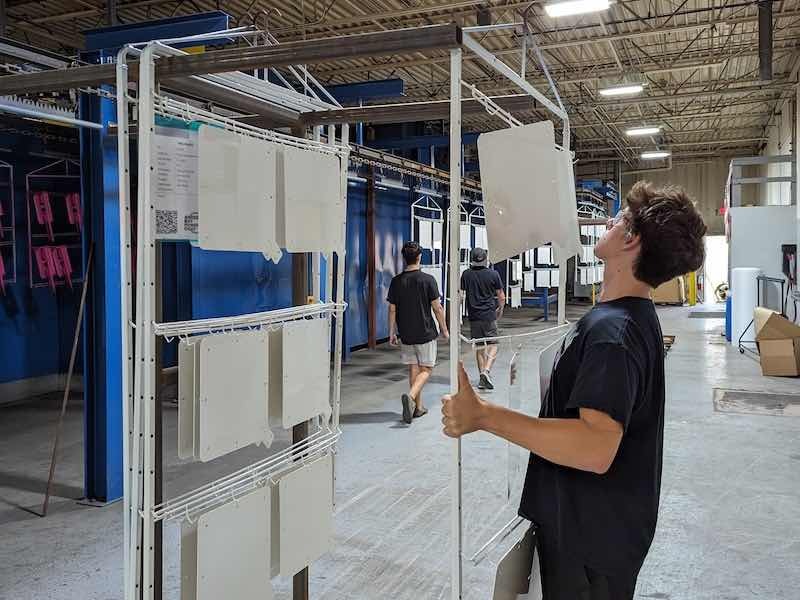 “I found an automated powder coat line and the new building, and everything lined up, and we got it all installed,” Thomas says. “While that was all happening, we had become so busy during the pandemic that we figured out we weren’t going be able to do it all out of one building. So we then decided to keep the original, one too.”
“I found an automated powder coat line and the new building, and everything lined up, and we got it all installed,” Thomas says. “While that was all happening, we had become so busy during the pandemic that we figured out we weren’t going be able to do it all out of one building. So we then decided to keep the original, one too.”
ABPC’s team — which has started removing equipment from the original location and moving it to the new one — then had to reinstall some equipment back at their original location. The increased business was a result of Thomas and his team becoming more aggressive in attracting customers during the pandemic when other finishing operations may have scaled back some.
“We are a little bit newer in the coating game than some people, so I’m probably a little more into it than a lot of my competition,” Thomas says. “They’ve been in it a lot longer, and I think when things got rough over Covid, I dove in.”
While many of ABPC’s competitors had problems with people not showing up for work — and not doing as much work as they scrambled to find bodies to apply coating for them — Thomas and his team took a different approach.
“I said, ‘Hey, if I have to do it myself, I don’t care because I’m not passing up the opportunity to get this work,’” he says. “It worked out for us, and we picked up a bunch of new customers. Yes, we struggled to keep ourselves staffed over Covid, but now we’re pretty well fully staffed again, and we have a lot of great, new customers.”
Change to Full-Time Powder Coating in 2011
 The company has two locations about 1.5 miles from each other: a 20,000-square-foot location that houses the original operation and a 33,000-square-foot spot that was needed to handle the additional work that ABPC has taken in over the last few years.ABPC was founded as an extension of R.A. Thomas Auto Body, which has provided liquid paint application services to customers for 30 years. They dabbled in powder coating for several years in the 1990s, and in 2009, when the economy slowed, Rob Thomas decided to push the family business further into powder coating as a way to grow the business.
The company has two locations about 1.5 miles from each other: a 20,000-square-foot location that houses the original operation and a 33,000-square-foot spot that was needed to handle the additional work that ABPC has taken in over the last few years.ABPC was founded as an extension of R.A. Thomas Auto Body, which has provided liquid paint application services to customers for 30 years. They dabbled in powder coating for several years in the 1990s, and in 2009, when the economy slowed, Rob Thomas decided to push the family business further into powder coating as a way to grow the business.
In 2013, Thomas changed the name of the company to Anchor Bay Powder Coat and went all-in with the powder coating operation.
Currently, they have a 1,000-foot automatic line with a booth size of 20 feet by 11 feet by 8 feet, with an oven size of 26 feet by 8 feet by 8 feet; they also have a second 1,000-foot line with a booth size of 28 feet by 16 feet by 12 feet with an oven size of 24 feet by 10 feet by 9 feet.
A big break for ABPC came during the pandemic when one of their customers — who had their own powder coating line — needed someone to coat about 80% of the parts they were getting from overseas that were already powder coated. With the pandemic, they could get the parts but not the coating, so they called ABPC to help them out.
“They were bringing in containers full of parts that were not coated,” Thomas says. “They asked us to fill in, and that came right when we got our automated line running. It was perfect timing, and it all lined up for us.”
Managing Business Operations During Growth
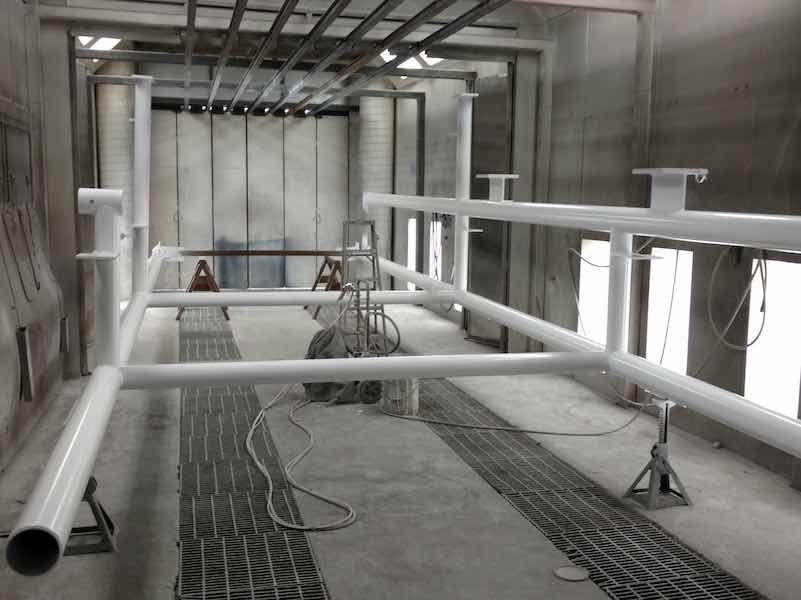 Anchor Bay Powder Coat has a 1,000-foot automatic line with a booth size of 20 feet by 11 feet by 8 feet, with an oven size of 26 feet by 8 feet by 8 feet; they also have a second 1,000-foot line with a booth size of 28 feet by 16 feet by 12 feet with an oven size of 24 feet by 10 feet by 9 feet.But as ABPC continued to grow, so did the headaches associated with keeping up with the business of the operation, namely managing throughput and keeping up with the challenge of new customers, more parts, and managing projects.
Anchor Bay Powder Coat has a 1,000-foot automatic line with a booth size of 20 feet by 11 feet by 8 feet, with an oven size of 26 feet by 8 feet by 8 feet; they also have a second 1,000-foot line with a booth size of 28 feet by 16 feet by 12 feet with an oven size of 24 feet by 10 feet by 9 feet.But as ABPC continued to grow, so did the headaches associated with keeping up with the business of the operation, namely managing throughput and keeping up with the challenge of new customers, more parts, and managing projects.
Suffice it to say, the old way of doing business was not going to handle the increased work or tracking projects and knowing where parts were in the coating process.
“When we took over from my parents, my mom was all pen and paper pretty much,” Thomas says. “We initially switched to QuickBooks, and it was fine. It was easy because once you were completed with that sales order and everything was good, you could convert it to an invoice, and it saved a little time.”
But even that computerized solution was starting to wear thin on ABPC’s overall operations. Thomas knew he needed a way to manage the coating operation — including having two locations — and marry it with business operations while having his team spend more time coating parts and less time writing down information.
Thomas says he spent a few years looking at various solutions that would work and says he poked around with one or two programs that just didn’t seem to fit into the structure of a coating operation.
Steelhead Technologies’ Integrated Solution
He had received a few inquiries from Steelhead Technologies’ integrated solution for finishing and coating operations but was so busy running the business he never seemed to have time to take a deeper look at what they offered. When Thomas finally did stop and see what they could do for him, he was impressed.
 “I finally realized that I did need to do something operationally,” he says. “Once I figured out that it was tailor-made for the coating industry, I realized that was one step in the right direction because it seemed like it was designed for us.”
“I finally realized that I did need to do something operationally,” he says. “Once I figured out that it was tailor-made for the coating industry, I realized that was one step in the right direction because it seemed like it was designed for us.”
Thomas presented his concerns to the Steelhead Technologies team: operational challenges in managing orders, certifications, specifications, and quality control. ABPC once relied on verbal orders — which became unmanageable — and transitioned to spreadsheets and later integrated QuickBooks for order tracking, but it lacked plant-specific visibility and operational data.
“This resulted in a lack of clarity and inefficient workflows,” says Chet Halonen, Sales and Deployment Engineer at Steelhead Technologies. “Managing certifications and specifications — especially for military projects — proved time-consuming and required meticulous attention to detail. And the paper-based documentation was prone to loss, leading to delays in project completion and customer frustration.”
Thomas says he was amazed at how the software platform truly understood what ABPC needed to accomplish on a daily basis in tracking projects and managing data. He says his team met with the Steelhead Technologies team on a regular basis to fine-tune the platform to the nuances of what data a powder coating operation needs to collect on a daily basis.
“It is amazing how they are tailoring the system to what we’re doing,” he says. “We still have to do some pen and paper for our certification processes where we are taking measurements, but they are keeping track of that on a template. They are building a process to eliminate all that. It’s going save so much time.”
Vital to Become Efficient in Certifications and Specifications Management Process
 Because ABPC does a lot of military application coatings, Halonen says it was vital for their software to help the shop become more efficient in the certifications and specifications management process.
Because ABPC does a lot of military application coatings, Halonen says it was vital for their software to help the shop become more efficient in the certifications and specifications management process.
“Previously, handling paperwork proved burdensome and error-prone,” he says. “Certificates, prints, and masking instructions were at risk of being lost or damaged, resulting in delays. By transitioning to a digital workflow, they eliminated these issues.”
Now, ABPC’s team simply scans the product, and all relevant information is stored securely within the platform. Generating certifications has become a streamlined process, requiring only a few clicks to create and send accurate certificates to customers.
It is something that the ABPC team has come to quickly realize how much more efficient they have become.
“Certifications are just so easy now,” says Sam Pugliese, ABPC Operations Manager. “Making a cert is literally just button clicking. You’re making sure you are inventorying all of your powders and choosing them on your work orders. You literally just click a button, a cert is auto-generated, you sign it on the screen, and send it to your customer. It streamlines it so fast.”
On the business side of the operation, Steelhead Technologies has seamlessly integrated with the ABPC QuickBooks system, enabling automated invoicing and enhancing visibility into invoice status. Sarah Thomas, ABPC’s Office Manager, says invoices generated within the platform are automatically converted into QuickBooks, saving time and eliminating the need for manual data entry.
Allowing Quality Team to Spend Time on Shop Floor
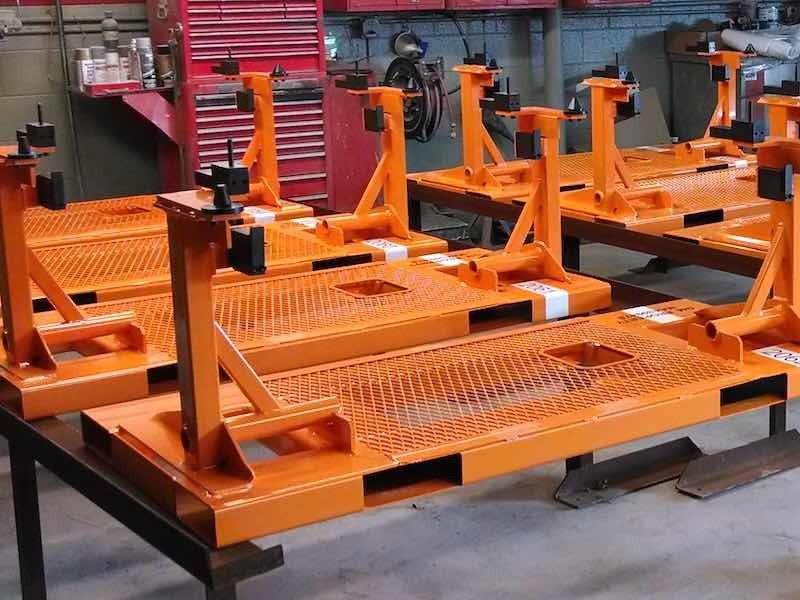 “I like that Steelhead can take the invoicing that I do and convert it automatically into QuickBooks,” Sarah Thomas says. “I am also able to see when customers are emailed their invoices and when they open their invoices.”
“I like that Steelhead can take the invoicing that I do and convert it automatically into QuickBooks,” Sarah Thomas says. “I am also able to see when customers are emailed their invoices and when they open their invoices.”
Quality Manager Tyler Burge says the new digital platform has enabled him to spend more time on the finishing line and less time doing paperwork.
“It saves me about two to three hours a day, which is huge,” says Burge, who adds that he saves about 40 to 60 hours a month, or about 5-8 business days. “Before, you had to track down paperwork from the customer that was maybe a couple of months old; it’s a lot easier now. You can see if someone made a mistake in the process, including who it was; it makes everything so much more streamlined and so much easier.”
Rob Thomas says the biggest benefit he sees with the Steelhead Technologies platform is how he can see what is happening on the coating lines at two different locations around the clock, where in the past, he didn’t feel he could be everywhere at once.
“It’s not just the time savings, but there is so much more traceability than what we’ve ever had before that,” he says. “That probably is honestly my favorite thing about the platform, even more than the time savings or anything like that. With that traceability, you can go back and look at every single transfer, when it was, and how long it was before the transfers.”
Previously, if a customer asked about parts shipped a week earlier — or the customer had any random question — Thomas and his team couldn’t provide an answer.
“Now, with Steelhead, I can literally — if there were 20 transfers — go back and look at every transfer,” he says. “Even if I have to talk to an employee, I can still say, ‘It was on Tuesday the 12th,’ and I can pinpoint even the time of day. It’s just amazing, especially with two shops; I’m just not as involved prior to two shops. Before I saw it with my own eyes. Now, a month later, if I want to look at what actually happened, that’s priceless to me.”
Visit https://anchorbaypowdercoat.com and https://gosteelhead.com





